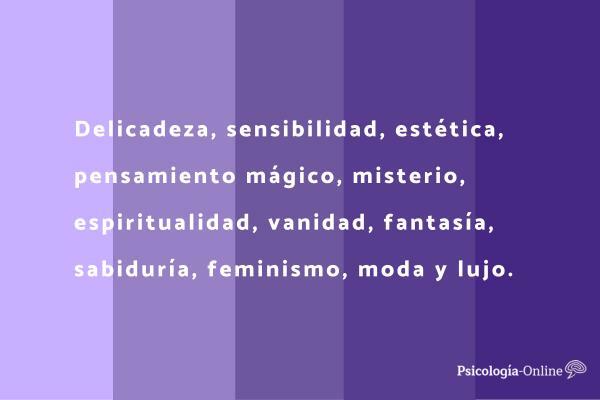
Purple is an intense color resulting from the union of red and blue and represents the conjunction of the force of the first with the stillness of the second. This color, in effect, is the result of the mixture of two contrasting, almost opposite tones, a characteristic that gives it a multitude of meanings: it is the color of transformation, of mystery, of constant search, sometimes also of suffering. Depending on its tonalities, it can evoke different sensations, all subject to individual interpretation. Jung defined purple, the color that is "between the human and the divine, the union of two natures." With this Psychology-Online article we will discover together the meaning of purple color in psychology.
Index
- What does the color purple mean
- Interpretations of the color purple
- The meaning of purple in cultures
- The color purple in neuromarketing
- The color purple in feminism
What does the color purple mean?
Purple is the meeting of two diametrically opposed colors both for their physiological and psychological meaning. The penetrating and active force of red is muffled by the satisfying calm of blue. Therefore the stimulus is ambiguous. You can think of purple as
From a psychological point of view, the lilac color expresses delicacy, aesthetic sensitivity and magical thinking. Sexuality (red) fades and transforms through blue into seduction, into an aesthetic dimension. Purple represents the transition between the two opposite colors blue and red and the achievement of the harmony of these two produces what N. Cusano calls "coincidentia oppositorum" and the highest level corresponds to mystical intuition. Also Levy-Bruhl, in his anthropological studies on tribal religions, was able to verify that purple is the color of magical identification and mystical participation.
The shape of purple is that of a rhombus (penetrating aspects of red) on the rounded sides (regressive and welcoming aspects of blue) that is distinguished by its harmony and balance.
Interpretations of the color purple.
Purple has been seen as the preferred color for people with hormonal and endocrinological disorders, including women throughout pregnancy and breastfeeding included. If purple is naturally preferred in girls, the exaggerated option of this color in adulthood may indicate infantilism, suggestiveness, seductive aspects, emotional lability and hypersensitivity. The rejection of purple indicates a blockage of one's own sensitivity for fear of having to renounce one's independence or for fear of exposing one's self to greater vulnerability. The rejection of purple is often accompanied by a susceptible and egocentric attitude, little inclined to empathy, sensitivity and identification.
The meaning of purple color in cultures.
Culture also influences the meaning given to the color purple. Let's see the meaning of the color violet in each context:
- What does the color purple mean in the spiritual? Purple is associated with mystery, mysticism, penance, the unconscious, secrecy, superstition, melancholy, death, fear, pity, frustration, fasting, fascination, humility, sleep and Magic.
- In Christianity, the lilac color is linked to repentance, atonement and recollection. Its primary colors, united in equal parts, represent wisdom and love. Indeed, on ancient paintings of the Passion of Christ, the Savior has been represented with a purple cloak. It is also an ecclesial color used during the Advent meditation period, which prepares for the feast of Christmas and Lent, the period of repentance before Easter.
- In the east, purple is linked to vice and evil, particularly in Japan it evokes sin and fear and that is why its use in marriages is prohibited.
- In Venezuela and Turkey, purple is associated with mourning.
- Purple is the seventh Chakra energy center.
- A sociological analysis shows that violet is one of the least appreciated colors by people.
The color purple in neuromarketing.
Purple in neuromarketing evokes mystery, spirituality, vanity, fantasy, magic, wisdom, fashion, success and luxury, and for this reason it is used in the cosmetics sector, especially perfumes and fashion (in general female), in the recreational sector, in the ecclesiastical sector, in the sector of childhood and communication.
It is advisable to use it to paint the walls of environments where concentration and solitude are needed because it seems that Helps to free themselves from heartaches and immerse themselves making it useful in writers' rooms or students. For the same reason, it is inadvisable in living rooms, such as living rooms and kitchens.
In the professional field, it seems that it is the color that inspires respect and institutionality and therefore could be used for medical and legal studies. In addition, it seems to be ideal in the bedrooms of couples in crisis because it would help to regain serenity and awaken desire.
The color purple in feminism.
Red and blue are the colors of sexual difference: its mixture awakens in women a sense of emancipation and the will not to be considered only in their feminine part, but as people in their entirety. Precisely for this reason the color purple is effective to become a symbolic spokesperson for the instances of the feminist movement.
This is where the term "purplewashing" was born: the prefix "purple" is associated with the belief of feminism while the verb "wash" is used to denounce co-optation strategies that use minority rights to maintain or reinforce structural forms of discrimination. In the context of feminism, it is used to describe a variety of political and marketing strategies to promote countries, individuals, businesses, and other organizations through a call for gender equality. The word is also used to criticize how Western countries that have not achieved full equality of Gender justify it by underlining that other countries or cultures have an even worse quality of life for women.
Know the history and currents of feminism.
This article is merely informative, in Psychology-Online we do not have the power to make a diagnosis or recommend a treatment. We invite you to go to a psychologist to treat your particular case.
If you want to read more articles similar to Meaning of the color purple in psychology, we recommend that you enter our category of Emotions.
Bibliography
- Cesarini Argiroffo, G. (2018). Il significato dei colori: il viola. Recovered from: https://www.giornaledipsicologia.it/il-significato-dei-colori-il-viola/
- Del Longo, N. (2011). Il test dei colori di Lüscher. Diagnostic manual in evolutionary age. Milan: Franco Angeli.


